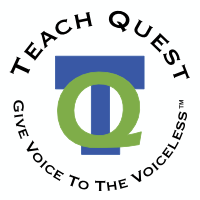@TEACH QUEST Global, we challenge All to:
- Give Voice to the Voiceless by empowering all peoples.
- Serve as an advocate of children and their parents.
- Expect high performance from yourself and your children.
- Demand effective and efficient teaching and learning practices.
- Support the creation of an educational system which maximizes achievement by all students, enabling them to become more productive as citizens, more creative as problem-solvers, and more effective as communicators of their own needs.
- Ensure that public accounting measures – authentic assessment tools and accountability systems – are equitable for all children.
@TEACH QUEST Global Foundation
Every educator’s mantra is, everyone can learn. The reality, however, is that everyone’s brain is wired to learn. According to the brain-based research (Alkon, Gage, Gazzangia, Greenough, Kosslyn, LeDoux, Crick, Rose, Damasio, Calvin, Herbert, Pert, Sacks, Edelman), our brains are programmed to learn as long as the brain is not prohibited from fulfilling its normal processes. As long as the learning process …gives equal weight to self discover patterns, connections, and interrelationships, or what is termed, whole-brained orientation, learning takes place.
Traditional teaching and learning strategies often center on a learning process focused on discouraging, ignoring, and punishing the learner through repeated routines. Routines deaden the brain process. Instead, the brain hungers for novelty. The human brain is evolutionarily primed to seek out and respond to what is unexpected or novel—new information. That process turns the brain on! In response to novelty, cortical activity is increased in more and varied areas of the brain (Katz & Rubin, 1999). Thus, the brain requires stimulation or exercise to switch it on. Katz and Rubin describe, a brain exercising program calls for presenting the brain with non-routine or unexpected experiences using various combinations of one’s physical sense—vision, smell, touch, taste, and hearing.
In our communities, the reverse may be true. Rather than exercising the brain, students are flooded, routinely, with “…data but often starved for meaningful learning”. Flooding learners with more data and information without delving into meaningful learning may be a result of the increased accountability placed on our teachers and students. In an effort to improve learner performance on high-stakes tests, individuals may not take the time to extract meaningful learning from data. Instead, pouring more data into learning, we promote more use of the left-brain.
Consequently, we are forced to favor left-brain modes of thinking while downplaying the right-brain ones, focusing more on acquiring data rather than manipulating the data to solve problems. However, understanding how to solve problems, what makes arguments plausible, and how to work with and work in a team are the main skills needed in today’s workplace. After all, with a click of the mouse any one can access more facts, names, and concepts. In the workplace, one must know what to do with the data. How does the data acquired fit with real-world practices and how quickly can one find more data? Employers want thinkers. They want employees with “people skills”. They want problem solvers, creativity, and team players: all right-brain skills. However, employers want employees with left-brain skill sets as well. They want employees who are linguistically fluent.
Responding to the new workplace which requires workers who can solve problems and create new ideas. There is no body of brain-based research that justifies every strategy for problem-solving and creating new ideas. However, new findings can steer all of us in more productive directions. The physiological aspects about the brain’s wiring may make sense for utilizing such strategies in the workforce.


Recent Comments